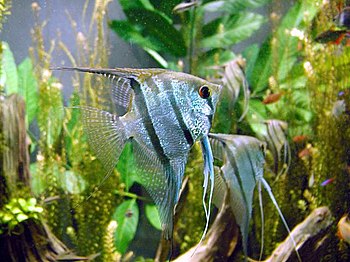This is a fish bigger than most aquarium varieties. The black Angel which comes from the Amazon basin area belongs to this category. Angelfish are also found in areas such as the Rio Tapajos and Orinoco. These fish feed on smaller live bait in the aquarium. They have a deep well-defined body structure. Their fins differ in color.
They have small, pouted lips and curved eyes. Some of them have black spots which are quite desirable with collectors of ornamental fish. Angelfish normally live in water temperatures of around 72 Fahrenheit, but the water needs to be warmer at 77 to 86 degrees, for them to start breeding. Keep them in subdued lighting conditions. These fish love the natural wild surroundings, so provide lots of plants in the aquarium to keep them satisfied. You need to keep them away from bright lights, which tend to make them a bit nervous. Angelfish have certain bones in the throat region, so do not get alarmed if you hear a noise when they breed.
The Rasbora Heteromorpha is a fish from this category. It is similar to the Cyprinidae family, and it is seen in the eastern Sumatra region, Thailand and Malaysia. It is a very attractive species with a thick body shape. It is colored a silver grey which shimmers when it moves. They normally have a patch of blue or black on the body as well. These fish grow up o about an inch and a half in length and they prefer to live in warm waters since they are from the tropical region. Keep the tank around 75-77 degrees if you house these fish. However, when they are breeding the water should be at a warmer level of say 82 degrees Fahrenheit. Keep the lighting subdued and provide ample room for them to swim around, they are quite active.
 |
| All Photos Wikipedia (CC) |
3. Scat
These fish belong to the Scatophagus Argus category and is closely related to the Scatophagidae. They are found in the eastern region of India. It is colored a brownish gold tone, with a sprinkle of brown spots all over the body. They are larger than other varieties discussed in this article and can grow to over eleven inches in length. Scats are hexagonal in shape. This fish prefers a well-lit area to live in, and you need to add salt to their water to keep them healthy. 3 or 4 teaspoons of salt in 2 to 3 gallons of water should do just fine. You could add sand into their tank rather than gravel, as well as some good hardy plants to make them feel at home. They enjoy eating the live bait, as well as a little from the plants. Use a good filter in their tank and you need to get ready to often change their water.
Abhishek is an avid Fish Lover and he has got some great Aquarium Care Secrets up his sleeves! Article Source: EzineArticles |




